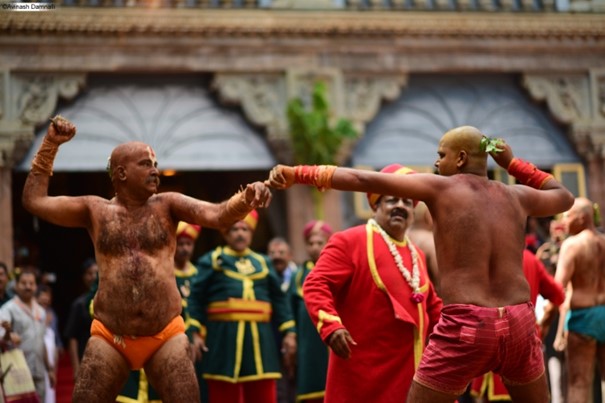October 27, 2023
Vajra Mushti Kalaga: The Ancient Indian Art of Thunderbolt Fist Wrestling

Introduction:
- Vajra Mushti Kalaga, a distinctive Indian martial art, integrates a blend of combat techniques including grappling, wrestling, and striking. Central to this form is the utilization of a knuckleduster, aptly named Vajra Mushti, crafted from animal horns and fitted onto the fighter’s knuckles.
The Art of Thunderbolt Fist:
- Vajra Mushti, translating to Thunderbolt Fist, revolves around the strategic use of this metal weapon. Its primary aim is to effectively neutralize the opponent while countering their weaponry.
The Role of the Knuckleduster:
- The Vajra Mushti, fashioned from animal horns, bestows a unique edge to this martial art. Worn on the knuckles, it amplifies the impact of strikes and enhances the fighter’s offensive capabilities.
Combat Dynamics:
- Unlike conventional grappling, Vajra Mushti entails a distinct style of wrestling. It involves two combatants, or jettys, attempting to land precise blows to each other’s heads with the knuckleduster. The objective is clear: the first to draw blood from the opponent’s head emerges as the victor.
Historical Significance:
- This form of wrestling gained prominence during the era of the Vijayanagar rulers, who held sway from the 14th to the 17th centuries. Its presence in the cultural tapestry of that period is testament to its significance.
Navaratri and the Portuguese Gaze:
- Medieval travelers from Portugal, while witnessing the Navaratri celebrations in the Vijayanagar empire, chanced upon this captivating form of wrestling. Their detailed accounts provide valuable insights into the intricacies of Vajra Mushti Kalaga.
Conclusion:
- Vajra Mushti Kalaga stands as a testament to the rich martial heritage of India, blending combat finesse with the ingenious use of specialized weaponry. Rooted in history, it remains a fascinating facet of Indian martial arts, offering a unique glimpse into the skills and strategies of a bygone era.
Gist of daily Article /The Hindu 17oct 2025
October 17, 2025
Daily Gist of the Hindu/Indian Express : 16 Oct 2025
October 16, 2025
Daily Gist of The Hindu/Indian Express: 6 Oct 2025
October 6, 2025
Daily Gist of Article /The Hindu /Indian Express: 24 Sep 2025
September 24, 2025
